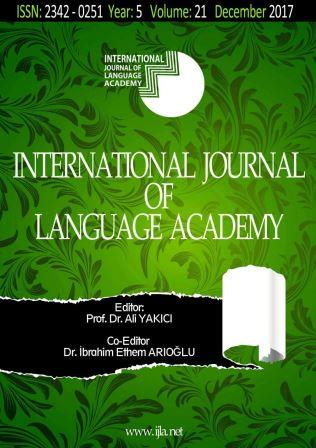Author :
Abstract
Bu çalışmada, Manisa İl Halk Kütüphanesi’nde 1474/2 numarada kayıtlı Hacı İbrahim Halife tarafından H.979’da yazılan “Silsile-nâme” adlı eser; konu, içerik ve imla özellikleri açısından incelenmiştir. Silsile-nâme, Divan Edebiyatı devrinde kişilerin seceresini vermek için, mesnevi tarzında yazılan edebi türlerden birisidir. Toplam on altı varaktır. Her varağın bir yüzü de on yedili, on sekizli, on dokuzlu mısralardan oluşmaktadır. Ancak eser numaralandırılmıştır. Eser, nesih yazısıyla yazılmıştır. Silsile-nâme harekesiz bir eser olmasına rağmen ya müstensih ya da şairin kendisi, okunmasında tereddüt edilebilecek kelimelere hareke koymak suretiyle okuma zorluklarını ortadan kaldırmaktadır. Yazmanın tarihinin 979/1573 olduğu eserin başındaki katolog fişinden ve yazmanın sonunda verilen tarihten anlaşılmaktadır. Silsile-nâme’nin elimizde tek bir nüshası olduğu için herhangi bir karşılaştırma yapamadık. Eser; hamdeleyle başlar. Salveleyle devam eder. Duayla bitirilir. Hacı İbrahim, konu itibariyle Hz. Ali’den, Hz. Hasan’dan, Hz. Hüseyin’den, On İki İmamdan söz etmektedir. Şeyhinin Şeyh Bedreddin Rumi olduğunu ifade eder, ona övgülerde bulunur. Tasavvuf esaslarından bahseder. Bir yandan zincirleme olarak kendi soyunun fertlerini anlatırken bir yandan da Allah’a ulaşırken çektiği çileleri ve yaptığı ibadetleri anlatır. İçerik, işleniş özellikleri ortaya konulduktan sonra, bu çalışmada; eserin imla özellikleri, Türkçe’nin bu dönemdeki özgün kullanılış biçimleri tespit edilmiştir. Eser 16. yüzyıl özelliklerini taşımakla birlikte Eski Anadolu Türkçesi ve Eski Türkçe’den unsurlar da taşımaktadır.
Keywords
Abstract
This study aims to examine and discuss Hacı İbrahim Halife’s “Silsile-name” (H.979) regarding its subject material, form and spelling. Silsile-name, as a lesser-known form in Turkish Courtly literature was a form in which family origins of individuals were tracked down in the manner o creating maintaining. A total of sixteen fires. However, the work is numbered. The work is written in a nesih text. One face of each entity consists of seventeen, eighteen, and nineteen millennia. Despite the fact that the Silsile-name is a work without motion either the poet or the poet himself removes the difficulties of reading by putting a motion on the words which may be hesitated to read. It is understood from the date of writing that the date of the writing was 979/1573 and the date of the writing. We did not make any comparisons because there is a single copy of the Silsile-name. İbrahim Halife’s “Silsile-name” starts with a “Thanks giving” (Hamdele), continues with reciting “Salavat”, and ends with a final prayer. Hacı İbrahim also refers to the major figures such as Hz. Ali, Hz. Hasan, Hz. Hüseyin and the twelve “İmams” in his work. The Sheikh expresses that Sheikh Bedreddin is a Rumi, and praises it. He mentions the principles of mysticism. On the one hand, it tells the descendants of their descendants in a chain, while on the other hand they describe the wives and the worship they have carried out while reaching Allah. After discussing formal consideratons and general treatment of the work, this study shall move on the examine its spelling, the usage at different dialects in Turkish, etc. The work seems to reflect typicial 16 th century characteristics but it aso represents “Ancient Anatolian Turkish” lingual properties and “Ancient Turkish” in general.
Keywords
- BANGUOĞLU, Tahsin (1998), Türkçenin Grameri, TDK, Ankara
- DENY, Jean (2004), Türk Dili Gramerinin Temel Kuralları (Türkiye Türkçesi),TDK. Ankara
- DEVELLİOĞLU, Ferit (2010), Osmanlıca-Türkçe Ansiklopedik Lûgat, Aydın Kitabeci, Ankara
- DİLÇİN, Cem (1983), Yeni Tarama Sözlüğü, TDK Yayınları, Ankara
- ERGİN, Muharrem (1993), Türk Dil Bilgisi, Bayrak Yayınları, İstanbul
- GÖLPINARLI, Abdülbâki (1984) Hazreti Ali Nehc’ül-Belāga,Hz. Ali’nin Hutbeleri, Vasiyetleri, Emirleri, Mektupları, Hikmet ve Vecizeleri, Der Yayınları, İstanbul.
- GÜLSEVİN, Gürer (1997), Eski Anadolu Türkçesinde Ekler, TDK, Ankara
- GÜLSEVİN, Gürer, Boz Erdoğan (2010), Eski Anadolu Türkçesi, Gazi Kitapevi, Ankara
- KANAR, Mehmet (2011), Osmanlı Türkçesi Sözlüğü, Say Yayınları, İstanbul
- KORKMAZ, Zeynep (1995), “Eski Anadolu Türkçesinde Aslì Ünlü (Vokal) Uzunlukları”, Türk Dili Üzerine Araştırmalar, C.1, TDK, Ankara
- KORKMAZ, Zeynep (1992), Gramer Terimleri Sözlüğü, TDK, Ankara
- ÖZKAN, Mustafa (2013), Türkiye Türkçesi Ses ve Yazım Bilgisi, Filiz Kitabevi, İstanbul
- SÂMİ, Semseddin (2002), Kâmûs-ı Türkî, Çağrı Yay., İstanbul
- TİMURTAŞ, Faruk Kadri (2012), Eski Türkiye Türkçesi, Kapı Yayınları, İstanbul
- Türkçe Sözlük (1998), TDK, Ankara





